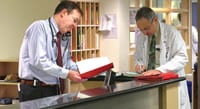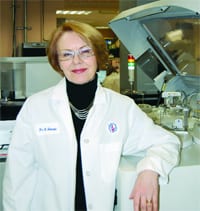Heart and Soul Berkshire Medical Center Commits To A Community Hospital Model
One of Dr. Robert Cella’s favorite examples of success within a community hospital framework is that of Berkshire Medical Center’s creation of a rapid response team assigned to work with patients experiencing cardiac arrest.
“We did some research and saw that teams such as these can have a dramatic impact on survival rates,” he said. “We created the team from existing staff, and for the cost of two beepers, we reduced mortality rates among those patients by 30{06cf2b9696b159f874511d23dbc893eb1ac83014175ed30550cfff22781411e5}.”
Rapid response teams like BMC’s, which has been in place for three years, are fast becoming commonplace at hospitals across the country, as international studies and data from hospitals like Berkshire Medical have proven they work to save lives. But Cella, vice president of Medical Affairs for Berkshire Health Systems, said BMC was one of the first hospitals in the country to put one in place, and added that it’s a testament to the ongoing quality-improvement initiatives at the hospital.
He also said the quality-improvement model at BMC has been built on a three-level foundation of community involvement, investment in advancing medical technology, and constant re-evaluation of both the strengths and weaknesses of all community hospitals, in order to capitalize on one and remedy the other.
Often, as he indicated, that means sizeable investments to create the safest, most effective hospital environment possible, and those investments are not something that BMC has historically shied away from.
“We are constantly working to upgrade our facilities and our medical practices in order to provide the best care possible for our community, and sometimes we joke that we’re a cash incinerator because of that,” said Cella. “But not all interventions have to cost millions of dollars.”
Helen Downey RN, chief operating officer at BMC, added that the medical center is currently operating in the black, and credited a progressive approach to providing care to the Berkshire community for that financial strength.
“We’re a strong organization with a strong presence in our community,” she said. “We’re dedicated to providing services the community needs, and we’ve invested a great deal in order to provide those services.
“But at the same time, we’ve remained financially strong,” she continued, “and we try to respond to new trends and recommendations as soon as possible to best serve the region’s population,” she said. “Lately, we’re seeing several new and changing programs that are exciting, and, more importantly, are proving to have a dramatic effect on patient care.”
Taking Initiative
Downey said it’s not about throwing money at a problem, it’s about investments of time and energy in addition to funds to provide the best services possible for the community a hospital serves, whether that population be large or small.
For BMC, the region it serves is smaller than many, but more unique than most. The hospital is the largest component of Berkshire Health Systems, which includes Fairview Hospital in Great Barrington and the Berkshire VNA, and is the county’s largest employer. It serves a wide geographical area that is largely rural, which poses its own set of challenges, but perhaps more pressing is Berkshire County’s distinction as home to, on average, the oldest residents in the Commonwealth.
What’s more, Cella added, that population experiences a 25{06cf2b9696b159f874511d23dbc893eb1ac83014175ed30550cfff22781411e5} increase during peak tourism periods (both summer and winter), which results in similarly sized surges in visits to BMC’s emergency room.
“We have an aging population that is highly dependent on us,” he explained, “and we’re not exactly a tourist destination for young people. More mature individuals need more medical services, and that’s an aspect of the community we serve that we have to be very cognizant of.”
That also means several issues more prevalent in aging populations are constantly on the hospital’s radar screen, such as diabetes, heart disease, and stroke. Those concerns drive advancements and additions to the facility’s repertoire of care.
“What it comes down to is constantly re-evaluating our scope of services, and how it can be broadened to make us as good as any community hospital can be,” he added, noting, for instance, BMC’s programs in heart disease treatment and prevention. “We’re making some great advances in the medical care of heart disease as well as preventative measures and education thereof, and that decreases the number of major surgeries that will arise.”
Similarly, Downey cited BMC’s advances in wound care as another response to growing community needs.
“We installed state-of-the-art hyperbaric chambers that have been proven to help heal wounds faster,” she said. “But that’s just an example of responding to one community need out of many.”
That’s because community response doesn’t boil down to simply offering procedures that will benefit many residents, she said. As part of the system that employs the most people in the area, it’s also intrinsic the BMC be part of the overall well-being of the region, in terms of health care, the economy, and safety.
BMC’s emergency preparedness programs, for instance, are extensive, and foster greater bonds between Berkshire communities and the hospital.
“We’ve received some attention for our efforts in emergency preparedness planning,” said Downey, “and many of our programs started before 9/11. We started emergency preparedness programs in direct response to the fact that everyone in the region is so dependent on us, and it has really become a community-wide effort.”
She explained that beyond drills to ensure the community is ready for several different types of emergencies, the emergency-preparedness initiatives also strengthen the hospital’s bonds with the region, including public entities such as police, fire, regional planning committees, and private entities, including ski resorts and other attractions.
Investing in Health
According to Ruth Blodgett, Berkshire Health Systems’ senior vice president of Planning and Development, health and wellness programs and emergency programs are the result of ongoing communication with the region, in order to best assess its wants and needs.
“The needs that face our hospital are similar to those that face many rural hospitals,” she said. “One of the most effective things we can do is reach out to people to find out what they need most, and address those needs first.”
Sometimes, Blodgett continued, addressing those needs does require a monetary investment, and in that arena BMC has also made strides in effectively directing funds – much of which are contributed by businesses and municipalities in the Berkshires – to capital improvements or additions to medical services.
BMC was the first hospital in Western Mass. to receive stroke center designation, for instance, and has also recently been designated a Level 2 trauma center. Eight operating rooms have been upgraded to each include the same level of technology – “they’re fully-loaded,” Blodgett said – and a recent redesign of one of the main areas of the medical center that created two sets of corridors – one internal for patients and a second external hallway for the public and visitors have improved workflow and privacy.
“We’ve made a real effort to create a warmer, friendlier space that is not so clinical,” she said. “We constantly strive to make home-like environments in which to provide excellent clinical care … it all goes back to that commitment to the community.”
In addition, a comprehensive reworking of entire first floor of the emergency center at a price tag of $7 million has been completed in recent years; a PACS (Picture Archiving and Communication System) has been integrated at a cost of $4 million, and a second MRI costing $1.5 million was installed.
Or, Downey added, the investment could take shape in the form of a new program rather than an addition to the facility itself.
We’ve worked very hard to secure a grant to train nurses, and made a bigger contribution than we might have otherwise done in the face of the nursing shortage,” she said, explaining further that BMC developed a program that allows current staff to enter the nursing program at Berkshire Community College and receive paid release time to assist in the process, as well as money for uniforms, books, and tuition.
The nurse-shortage program has proven successful – 59 students have graduated from the program, and another 58 are currently enrolled.
“In many cases, those investments allow us to recruit the best physicians possible,” she said. “They come to see the hospital and they’re impressed by nurse staffing patterns. Patient safety is a top priority for us, we see it as a value and so do many physicians.”
We Want You…
Indeed, recruitment has become a central focus for BMC’s management in recent years, as it continues to expand the quantity and quality of its services by attracting the best and the brightest to the region. It’s a subject that ties in directly with those unique challenges that face rural hospitals, Cella said, but can also translate into some of the greatest advances for a community hospital.
“Our population in the region is not that large, although geographically we cover a lot of area,” he said. “It’s an area that on its own has trouble supporting high-end specialists, so over the last couple of years we’ve been much more involved in recruiting and hiring physicians that support key services.”
Cella said one neurosurgeon and a neurologist who recently joined the BMC team are probably two of the best examples of finding personnel and aggressively recruiting them to augment BMC’s suite of services.
“It’s extremely challenging to recruit neurosurgeons,” he said. “It’s a difficult discipline that requires an exceptional amount of training, and fewer doctors are getting into it.”
Cella added that recruitment, especially in such a competitive area as neurosurgery or other high-demand areas of expertise such as anesthesiology, can be both a costly and a lengthy process.
“It requires quite a bit of planning, evaluation of current staff and that which we need to grow, and collaborations with several different firms to find personnel,” he said. “I think we’re successful because we’ve reached a sort of tipping point — we have an existing crew of very skilled physicians and we’ve invested quite a bit in plant and technology — that also impresses the doctors we are seeking out.”
And Cella said he won’t negate the importance of the Berkshire lifestyle when recruiting new physicians. Rather than try to downplay the easy, laid-back way of life in the region, the hospital routinely plays it up as an attractive alternative to the fast-paced urban lifestyle of many larger medical centers.
“Frankly, the people we get are those who want to come here for the lifestyle,” he admitted. “Those who don’t want to sit in traffic, or who have strong ties in music, or young families they want to raise here.”
Cella said one gastroenterologist, in fact, signed his contract based largely on his love for skiing, and the fact that he could leave his rounds and be on the slopes in 20 minutes or less.
Turning (on) the Page
“Because of the unique makeup of our community, we have taken on a broader role in recruitment than some,” he said. “And one word bolsters that decision – commitment. It’s about getting what the community needs and providing it in the best way possible. Sometimes that’s a costly renovation, or a community-based program that can provide better care, better jobs, or economic development.”
Or sometimes, it’s writing a purchase order for a new beeper and some batteries, and putting them in the hands of the most capable person.
Jaclyn Stevenson can be reached at stevenson@healthcarenews.com



Comments are closed.